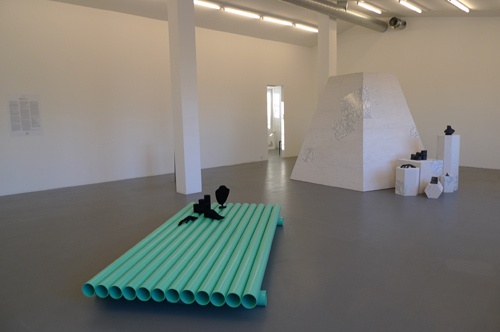 |
| Jonas Nobel, view of Display of Loss—This Play We Lost, 2010, image: Galleri Charlotte Lund |
A narrative installation inspired by his mythical novel that also serves as an entry point, Jonas Nobel’s fourth solo exhibition, “Display of Loss—This Play We Lost,” offers his svelte sculptural version of a raft, as well as a geometric mountain range and a porthole-framed sketch with view of a tumultuous sea. The works are connected to the novel Nobel has written, which shares a title with the exhibition and tells the story of a burdened crew destined to fail in delivering unwanted merchandise to an infinite number of harbors, instead ending up shipwrecked on an island, disillusioned, and haunted by memories from their earlier lives.
Nobel hints that this exhibition’s essence is located in an undefined yet codependent space between the actual installation and his novel’s text. Inspired by a political climate of unfulfilled expectations, unpredictable results, and the cycle of consumption and waste, the Stockholm-based artist highlights the unreasonable thirst for more, allegorizing the consequences of unwarranted mass production. Displayed alongside the aforementioned objects is an artist’s book by Nobel titled The memory of this experience will fade and you will eventually die I’m sorry I’m so very very sorry, which includes exclamations such as “If you hurt me like this again I’ll fucking kill you,” and “Don’t worry the violence during night will end in the morning”—words linked to Nobel’s previous works in a text-image juxtaposition in the pages of his book. Strong-willed but soft with careful concern, “Display of Loss—This Play We Lost” exemplifies the ongoing romance afloat between fiction and art.To see the review in context, click here.








